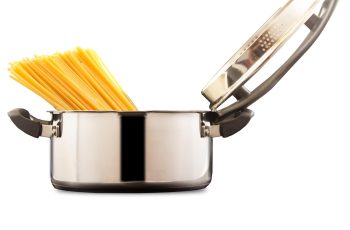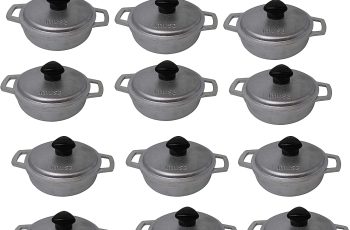Ad Blocker Detected
Our website is made possible by displaying online advertisements to our visitors. Please consider supporting us by disabling your ad blocker.
In this article, you will explore the remarkable journey of saucepan designs, tracing their evolution from humble beginnings to innovative advancements. From the basic Terra Cotta pots of ancient civilizations to the intricately designed and technologically enhanced saucepans of the modern era, this exploration will highlight the significant milestones that have shaped the world of cookware. By understanding the historical and cultural influences behind the development of saucepan designs, you will gain a profound appreciation for the ingenuity and craftsmanship that has continuously elevated culinary experiences throughout history.
Ancient Saucepan Designs
Ancient civilizations have long recognized the importance of cooking vessels in preparing meals. Early examples of cooking vessels, including saucepans, can be traced back to ancient civilizations such as the Egyptians, Mesopotamians, and Chinese. These early saucepans were typically made from clay or ceramic materials and were used to boil or simmer food over an open flame or hot coals. Although simple in design, these early saucepans laid the foundation for future innovations in culinary tools.
With the advent of bronze, saucepan designs started to evolve during the Bronze Age. The introduction of bronze saucepans brought about significant advancements in both functionality and durability. Bronze, an alloy of copper and tin, provided greater heat conductivity than clay or ceramic materials, allowing for more efficient cooking. These early saucepans were often adorned with intricate engravings and handles made from other metals such as copper or iron.
The influence of Roman and Greek cultures played a vital role in the development of saucepan designs during ancient times. The Romans, known for their culinary prowess, introduced improvements such as long handles, allowing for more comfortable maneuverability while cooking. The addition of spouts also facilitated pouring and reduced the risk of spills. The Greeks, on the other hand, contributed to the artistry of saucepan designs, often adorning them with intricate patterns and decorative handles.
Medieval and Renaissance Era Saucepans
During the medieval and Renaissance eras, saucepan designs continued to evolve as new materials and metalworking techniques were introduced. Iron, a more accessible and affordable material than bronze, began to replace it as the primary choice for saucepan construction. Iron saucepans offered greater durability and resistance to high temperatures, making them ideal for prolonged cooking periods.
Innovation in handles and lids became apparent during this period. Handles were often forged directly onto the saucepan body, providing stability and strength. Lids were introduced to trap heat and moisture, enhancing the cooking process. These improvements allowed for more precise temperature control and resulted in more flavorful and tender dishes.
As culinary traditions developed independently across regions, regional variations in saucepan designs emerged. For example, in Mediterranean countries, long-handled saucepans with wide bases were popular for cooking traditional dishes like paella. In contrast, in Nordic countries, saucepans designed for outdoor cooking were commonly used, featuring heavy lids to withstand harsh weather conditions and long cooking times.
18th Century Saucepan Innovations
The 18th century witnessed numerous innovations in saucepan designs, driven by advancements in manufacturing techniques and changing preferences of the culinary world. Copper saucepans gained popularity during this period due to their superior heat conductivity. Copper’s ability to quickly and evenly distribute heat resulted in precise cooking control, making it a favorite among professional chefs and home cooks alike.
Advancements in manufacturing techniques, such as the introduction of stamping and pressing methods, allowed for the mass production of saucepans. This made saucepans more affordable and accessible to a wider range of individuals. Additionally, the invention of the double boiler, a saucepan within a saucepan, revolutionized the cooking of delicate dishes such as custards and sauces, as it provided a gentle and controlled heat source.
Industrial Revolution and Modern Saucepans
The Industrial Revolution marked a significant turning point in the production and availability of saucepans. The shift to mass production in factories led to the production of saucepans on a much larger scale, making them more affordable for the general population. This mass production also saw the introduction of new materials, such as stainless steel.
The introduction of stainless steel revolutionized saucepan designs. Stainless steel, an alloy of iron, chromium, and nickel, offered superior durability, resistance to corrosion, and ease of maintenance. It quickly became the material of choice for professional kitchens and home cooks alike. Stainless steel saucepans also allowed for a more hygienic cooking experience, as they were non-reactive to acidic ingredients.
The influence of technology further shaped modern saucepan designs. In recent years, the introduction of induction-compatible saucepans has provided cooks with greater flexibility in their choice of stovetop. Induction cooking, which relies on electromagnetic fields to generate heat, requires specific materials, such as iron or stainless steel, for the saucepan to work effectively.
Innovative Materials and Designs
The pursuit of innovation in saucepan designs has led to the introduction of various materials and designs that have revolutionized the cooking experience. One of the most significant developments was the advent of non-stick coatings. These coatings, such as Teflon, revolutionized cooking by reducing the need for excessive amounts of oil or butter, resulting in healthier and easier-to-clean meals.
The introduction of induction-compatible saucepans allowed for the efficient transfer of heat, resulting in faster cooking times and reduced energy consumption. These saucepans are specifically designed with a magnetic bottom that interacts with the induction cooktop, ensuring optimal heat distribution. As induction cooking continues to gain popularity, the demand for induction-compatible saucepans is expected to rise.
Sustainability and eco-friendliness have also become essential considerations in modern saucepan designs. Cookware manufacturers have begun prioritizing the use of recycled and recyclable materials, as well as implementing eco-friendly production processes. Saucepan designs now aim to reduce environmental impact while still offering exceptional durability and cooking performance.
Multifunctional Saucepan Designs
Recognizing the desire for versatility in the kitchen, saucepan designs have evolved to incorporate multifunctional features. A popular innovation is the saucepan with a strainer insert. This design allows for easy straining of pasta or vegetables directly from the saucepan, eliminating the need for a separate colander or strainer. The strainer insert fits securely into the saucepan, ensuring safe and efficient straining.
Another multifunctional design is the saucepan with a steamer basket. This addition allows for steaming vegetables, seafood, or dumplings while simultaneously cooking a liquid or sauce. The steamer basket is placed inside the saucepan, and the steam generated from the boiling liquid below cooks the food placed in the basket. This design promotes healthy cooking methods and saves time and effort in the kitchen.
The saucepan with a wide bottom has also gained popularity due to its versatility and efficiency. The wider surface area allows for better heat distribution, resulting in faster cooking times and more even heat throughout the pan. This design is ideal for browning meat, reducing sauces, or preparing larger quantities of food. The wide bottom also provides ample space for stirring and allows for better food contact with the heat source.
Specialized Saucepan Designs
Catering to specific cooking needs, specialized saucepan designs have emerged to facilitate the preparation of specific dishes. A saucepan for candy making, for example, features a precise temperature control system, commonly in the form of a built-in thermometer. This ensures that the candy syrup reaches the exact temperature required for a successful result, such as the firm ball stage for fudge or the hard crack stage for toffee.
A saucepan designed specifically for sauces and reductions often features a wide, shallow shape. This design allows for faster evaporation and concentration of flavors, resulting in richer and more intense sauces. The wide shape also promotes easy whisking and stirring, allowing for efficient reduction without scorching.
For the perfect poached eggs, a saucepan designed with individual egg cups or inserts has become a popular choice. These inserts hold the eggs separately, preventing them from spreading and resulting in beautifully shaped poached eggs. This design eliminates the need for swirling water or vinegar and ensures consistent and visually appealing results.
Influence of Ergonomics
The importance of ergonomics in saucepan design cannot be overstated. Handle design is crucial for comfort and control while using a saucepan. Many manufacturers focus on creating handles that are heat-resistant, non-slip, and ergonomically shaped to fit comfortably in hand. These features minimize the risk of accidental burns and allow for easy maneuverability.
Weight distribution in a saucepan is also an essential factor in its ease of use. A well-designed saucepan should have a balanced weight distribution, allowing for comfortable lifting and pouring. Ideally, the weight should be evenly distributed between the handle and the base of the saucepan, preventing strain on the wrist and providing stability during pouring.
Improved lids with steam venting features have become an integral part of modern saucepan designs. Steam vents allow excess steam to escape, preventing pressure build-up and reducing the risk of boiling over. This feature helps maintain a controlled cooking environment and ensures that food retains its desired texture and flavor.
Saucepan Design and Heat Distribution
The choice of materials in saucepan design significantly impacts heat distribution and cooking performance. Each material has unique properties that affect how efficiently and evenly heat is conducted throughout the pan. Copper, for example, exhibits excellent heat conductivity, allowing for quick and precise temperature adjustments. Stainless steel, while not as conductive as copper, offers superior durability and versatility.
Another crucial aspect of saucepan design is the thickness of the base. A thicker base ensures that heat is distributed uniformly, preventing hot spots and promoting consistent cooking. The combination of even heat distribution and optimal heat conduction allows for better control over the cooking process, resulting in evenly cooked and flavorful meals.
Optimal heat conduction is achieved through a combination of the material’s properties, the thickness of the base, and the design of the construction. Quality saucepans often incorporate multiple layers of different metals, such as stainless steel or aluminum, in the base. This layering maximizes heat conduction while providing durability and compatibility with different cooktops.
Future Trends in Saucepan Designs
As technology continues to advance, the integration of smart technology into saucepan designs is expected to become more prevalent. Imagine a saucepan with built-in sensors that can monitor the internal temperature of food, providing real-time feedback and ensuring precise cooking results. Connected saucepans that communicate with smartphones or other kitchen appliances may soon become a reality.
Energy efficiency is also a growing concern in modern society, and future saucepan designs are likely to incorporate innovative features to reduce energy consumption. Improved heat retention, optimized heat conduction, and specialized insulation materials could contribute to more energy-efficient cooking processes.
Customizable and modular saucepan designs could also become more prevalent in the future. Cookware that allows for interchangeable handles, different-sized inserts, or stackable components would offer greater versatility in the kitchen. This would allow individuals to customize their saucepans according to their specific cooking needs, maximizing functionality while minimizing storage space.
In conclusion, the evolution of saucepan designs has been influenced by various factors, including advancements in materials, manufacturing techniques, and changing culinary preferences. From ancient saucepans made of clay to modern stainless steel creations, saucepan designs have continuously evolved to meet the demands of a diverse range of cooking styles. With a focus on innovation, ergonomics, and sustainable practices, the future of saucepan designs promises even greater convenience and efficiency in our culinary endeavors.

